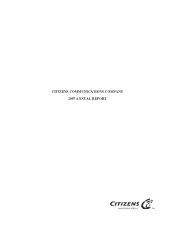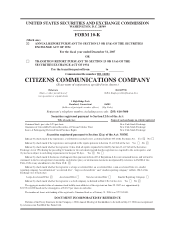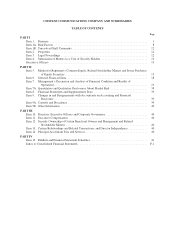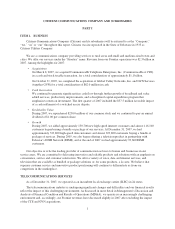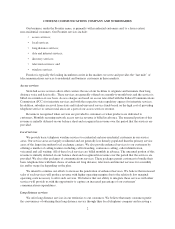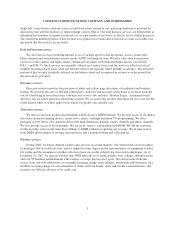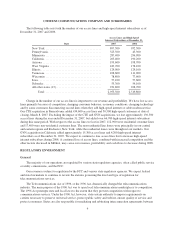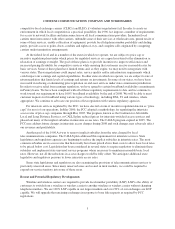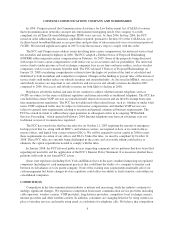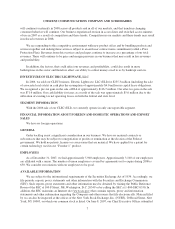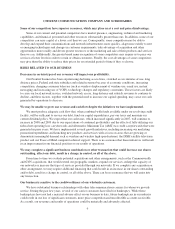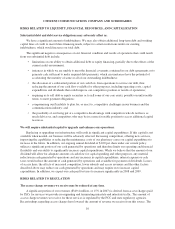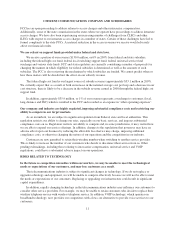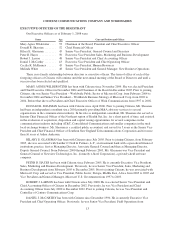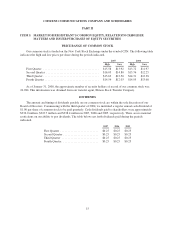Frontier Communications 2007 Annual Report Download - page 9
Download and view the complete annual report
Please find page 9 of the 2007 Frontier Communications annual report below. You can navigate through the pages in the report by either clicking on the pages listed below, or by using the keyword search tool below to find specific information within the annual report.CITIZENS COMMUNICATIONS COMPANY AND SUBSIDIARIES
competitive local exchange carriers (CLECs) and ILECs if voluntary negotiations fail. In order to create an
environment in which local competition is a practical possibility, the 1996 Act imposes a number of requirements
for access to network facilities and interconnection on all local communications providers. Incumbent local
carriers must interconnect with other carriers, unbundle some of their services at wholesale rates, permit resale of
some of their services, enable collocation of equipment, provide local telephone number portability and dialing
parity, provide access to poles, ducts, conduits and rights-of-way, and complete calls originated by competing
carriers under termination arrangements.
At the federal level and in a number of the states in which we operate, we are subject to price cap or
incentive regulation plans under which prices for regulated services are capped in return for the elimination or
relaxation of earnings oversight. The goal of these plans is to provide incentives to improve efficiencies and
increased pricing flexibility for competitive services while ensuring that customers receive reasonable rates for
basic services. Some of these plans have limited terms and, as they expire, we may need to renegotiate with
various states. These negotiations could impact rates, service quality and/or infrastructure requirements which
could impact our earnings and capital expenditures. In other states in which we operate, we are subject to rate of
return regulation that limits levels of earnings and returns on investments. In some of our states, we have been
successful in reducing or eliminating price regulation on end-user services under state commission jurisdiction.
In order to receive relief from earnings regulation, we have agreed to certain broadband availability commitments
in Pennsylvania. We have been compliant with all of those regulatory requirements to date and we continue to
work toward our requirement to have 100% broadband availability by the end of 2008. We will be able to meet
customer requests for broadband using various types of technology, including DSL, T1 and wireless, where
appropriate. We continue to advocate our position of less regulation with various regulatory agencies.
For interstate services regulated by the FCC, we have elected a form of incentive regulation known as “price
caps” for most of our operations. In May 2000, the FCC adopted a methodology for regulating the interstate
access rates of price cap companies through May 2005. The program, known as the Coalition for Affordable
Local and Long Distance Services, or CALLS plan, reduced prices for interstate-switched access services and
phased out many of the implicit subsidies in interstate access rates. The CALLS program expired in 2005. The
FCC may address future changes in interstate access charges during 2008 and such changes may adversely affect
our revenues and profitability.
Another goal of the 1996 Act was to remove implicit subsidies from the rates charged by local
telecommunications companies. The CALLS plan addressed this requirement for interstate services. State
legislatures and regulatory agencies are beginning to reduce the implicit subsidies in intrastate rates. The most
common subsidies are in access rates that historically have been priced above their costs to allow basic local rates
to be priced below cost. Legislation has been considered in several states to require regulators to eliminate these
subsidies and implement state universal service programs where necessary to maintain reasonable basic local
rates. However, not all the reductions in access charges would be fully offset. We anticipate additional state
legislative and regulatory pressure to lower intrastate access rates.
Some state legislatures and regulators are also examining the provision of telecommunications services to
previously unserved areas. Since many unserved areas are located in rural markets, we could be required to
expand our service territory into some of these areas.
Recent and Potential Regulatory Developments
Wireline and wireless carriers are required to provide local number portability (LNP). LNP is the ability of
customers to switch from a wireline or wireless carrier to another wireline or wireless carrier without changing
telephone numbers. We are 100% LNP capable in our largest markets and over 99% of our exchanges are LNP
capable. We will upgrade the remaining exchanges in response to bona fide requests as required by FCC
regulations.
5

